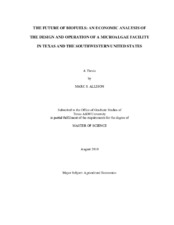| dc.description.abstract | The world of energy is changing. With rising energy costs and concerns over the
supply of energy materials, more research is being conducted into alternative sources of
fuel and microalgae is one of the sources being researched, although much research had
been conducted on it as a part of the Aquatic Species Program from the 1970s to the
early 1990s. With the emergence of microalgae as a source of alternative energy, the
need for an economic analysis of microalgae has arisen. This research studies the
economic feasibility of the design and operation of a microalgae production facility in
two Texas locations (Pecos and Corpus Christi) and in southeastern New Mexico using a
stochastic simulation model. It examines the production levels needed for the facility to
be profitable and also some facility designs necessary for that profitability. It also
measures several annual financial indicators so that potential investors have some
estimates of the future profitability of the microalgae industry.
The results show that for microalgae to become a viable commercial operation,
production must be improved beyond the current levels and the levels suggested by the
literature. Production needs to be at least 0.8 g/L/day with 40 percent oil content and 24 inches of water depth. Production must be improved through increasing growth rates and oil
contents at greater water depths. Production can be improved through nutrient and
carbon dioxide usage, two elements that are being heavily researched. Water usage will
become a major focus because of the limited resources and the quantities necessary to
operate a commercial-scale facility. With the necessary improvements in technology
and research, microalgae could prove to be a viable source of alternative energy. | en |


